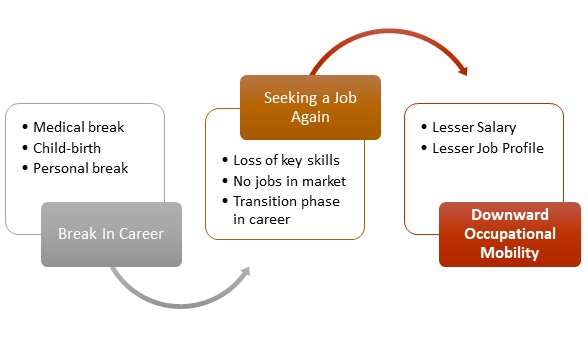- Business Concepts ›
- Human Resources (HR) ›
- Downward Occupational Mobility
Downward Occupational Mobility
Definition, Importance & Example
This article covers meaning & overview of Downward Occupational Mobility from HRM perspective.
What is meant by Downward Occupational Mobility?
Downward occupational mobility is when a person takes up a job that has lesser a job profile or salary than the previous job held by him or her. Downward occupational mobility usually takes place when the person takes a break from his/her career due to various reasons like childbirth or injury etc. Employees usually accept the transitional job by downward occupational mobility to support their families or because there might not be a similar job available in the market for the person anymore.
The firms think that after a break the person might not have the same competencies as before and would hire the person for a lower paying job. Downward occupational mobility might also take place if the person may not be able to work with the same efficiency or upto the same level as before the break taken by the person.
Importance of Downward Occupational Mobility
Downward occupational mobility is quite a common phenomenon for employees to be hired for a job that has a salary lower than their previous job’s salary especially if they have taken a break. India has rules against this practice in case a woman returns to work after maternity leave, the employer has to hire the employee back at the same salary and the same position as before the woman went on maternity leave. In countries like USA where there is no maternity leave and mother would have to leave their jobs. They are then hired by either the same firm or by another firm for a lower salary because having a baby might affect their ability to work and also new mothers would require to take care of their babies so the amount of work assigned to them is very less and thus they are compensated accordingly.

Advantages of Downward Occupational Mobility
Some pros of downward occupational mobility are:
1. Helps unemployed people get on a job when there are limited options available
2. Companies might get a very good candidate at a lower salary
Disadvantages of Downward Occupational Mobility
Some drawbacks of downward occupational mobility are:
1. The organization might lose brand value if they would re-hire employees for a lower salary.
2. Employee morale would be lowered if the person is hired at a lower salary.
3. Employees may not want to join the organization, if the organization has practices which shows that it does not take care of its employees.
Example of Downward Occupational Mobility
Amanda was working in the United States and gave birth to a baby, she had to resign from her current job to take care of the baby. After about 18 months when she thought she was ready to work again she decided to approach her firm again for a job. The firm wanted her back but were not ready to give her, her previous position back they wanted to hire her for a lower salary in a slightly lower position. Amanda was not happy with the offer and decided to look for a job which was at least offering the same compensation. After searching the market throughout she found out that firms were not even paying her the amount her previous firm was willing to pay, so she had to accept the job of her previous organization and this is known as downward occupational mobility.
Hence, this concludes the definition of Downward Occupational Mobility along with its overview.
This article has been researched & authored by the Business Concepts Team which comprises of MBA students, management professionals, and industry experts. It has been reviewed & published by the MBA Skool Team. The content on MBA Skool has been created for educational & academic purpose only.
Browse the definition and meaning of more similar terms. The Management Dictionary covers over 1800 business concepts from 5 categories.
Continue Reading:
What is MBA Skool?About Us
MBA Skool is a Knowledge Resource for Management Students, Aspirants & Professionals.
Business Courses
Quizzes & Skills
Quizzes test your expertise in business and Skill tests evaluate your management traits
Related Content
All Business Sections
Write for Us